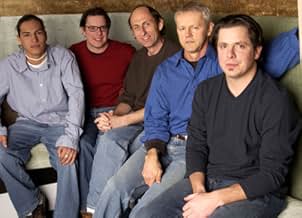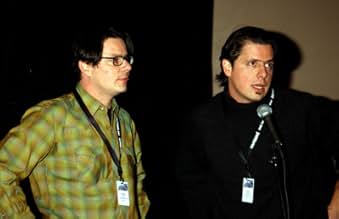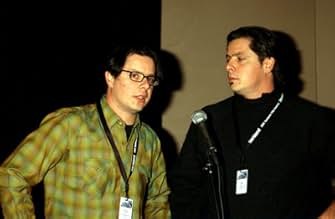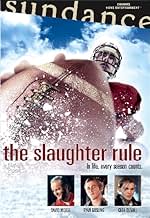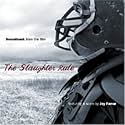IMDb-BEWERTUNG
5,9/10
2796
IHRE BEWERTUNG
Füge eine Handlung in deiner Sprache hinzuA young man finds solace with a young woman, his mother, and a high-school football coach who recruits him to quarterback a six-man team.A young man finds solace with a young woman, his mother, and a high-school football coach who recruits him to quarterback a six-man team.A young man finds solace with a young woman, his mother, and a high-school football coach who recruits him to quarterback a six-man team.
- Regie
- Drehbuch
- Hauptbesetzung
- Auszeichnungen
- 2 Gewinne & 2 Nominierungen insgesamt
John Henry Marshall
- Matt Kibbs
- (as John Henry Marshall III)
Empfohlene Bewertungen
9B24
As a subscriber to Sundance Channel, I am intrigued by recurrent programming patterns in the films shown. Recently, for example, there has been a spate of male-oriented psycho-sexual dramas that go deeply into themes usually represented in mainstream cinema as subconscious or accidental phenomena.
In The Slaughter Rule as well as other recent offerings like L.I.E. or Priest or Taboo (originally Gohatto), characters reveal emotions that seem designed specifically to break new ground in the amorphic area between ordinary storytelling and what some would call pornography. The common word to describe this is "disturbing." But just as Who's Afraid of Virginia Woolf, Midnight Cowboy, and Harold and Maude opened people's eyes in the 60's and 70's to the possibilities of "disturbing" cinema as literature, these new films may lead in my view to an entirely new public attitude about the inherent validity of the effort.
To be sure, The Slaughter Rule is a flawed film. So are many others of its kind to date. Its premise, however, is sound. One can nitpick about cinematic values, geographical anomalies, or plot distractions, etc., but to be able to see disparate fictional characters get under each other's skin is what makes any drama come to life. Added to that in this case is a very competent job of producing, directing, and editing. Moreover, no one can quarrel with the acting performance of David Morse.
Coming to grips with overtly sexual themes in films -- particularly those that deal seriously with "disturbing" but very real kinds of human emotions -- is a challenging task not only for moviemakers like the Smiths, but also for viewers. I give this movie an "E" for effort and a solid 9 out of 10 for everything else.
In The Slaughter Rule as well as other recent offerings like L.I.E. or Priest or Taboo (originally Gohatto), characters reveal emotions that seem designed specifically to break new ground in the amorphic area between ordinary storytelling and what some would call pornography. The common word to describe this is "disturbing." But just as Who's Afraid of Virginia Woolf, Midnight Cowboy, and Harold and Maude opened people's eyes in the 60's and 70's to the possibilities of "disturbing" cinema as literature, these new films may lead in my view to an entirely new public attitude about the inherent validity of the effort.
To be sure, The Slaughter Rule is a flawed film. So are many others of its kind to date. Its premise, however, is sound. One can nitpick about cinematic values, geographical anomalies, or plot distractions, etc., but to be able to see disparate fictional characters get under each other's skin is what makes any drama come to life. Added to that in this case is a very competent job of producing, directing, and editing. Moreover, no one can quarrel with the acting performance of David Morse.
Coming to grips with overtly sexual themes in films -- particularly those that deal seriously with "disturbing" but very real kinds of human emotions -- is a challenging task not only for moviemakers like the Smiths, but also for viewers. I give this movie an "E" for effort and a solid 9 out of 10 for everything else.
Sometimes technical flaws can get in the way of what otherwise could have been a good story. These movie's flaws prevented me from enjoying it much.
First, two key deleted scenes from the start of the film leave the entire premise feeling hollow. The scenes are offered as a special feature on the DVD. If I were to watch this movie again, I'd play these two deleted scenes where they should have been. First, the scene deleted after the conversation about the teen's father that opens the movie. Second, just minutes later the continuation of a scene talking with the coach in his office.
This has been a growing trend, for directors to cut key scenes that explain things at the start of the movie. In at least commentary tracks directors have said they 'just wanted to get on with the movie'. Well of course they might, since they know the story intimately. The viewer won't, and could use the background to make an emotional connection to the movie. Unless the movie is past the two hour mark, why consider cutting valuable scenes?
Gosling and some of the other performances were great. Of course Gosling does great even in rotten movies like Murder By Numbers.
The wide screen was an overly wide aspect, I guess meant to highlight those beautiful outdoor scenes over the actors. It leaves barely enough room for actors' heads in places, and it made the brief shower scene no fun at all. To echo another comment, the sound was very poor in places. More than accents, it was bad mixing where sound jumped from soft whisphers to loud music then back. My finger ended up fiddling with the volume throughout.
In hindsight, I might watch The Slaughter Rule once, but it won't be worth watching even a second time.
First, two key deleted scenes from the start of the film leave the entire premise feeling hollow. The scenes are offered as a special feature on the DVD. If I were to watch this movie again, I'd play these two deleted scenes where they should have been. First, the scene deleted after the conversation about the teen's father that opens the movie. Second, just minutes later the continuation of a scene talking with the coach in his office.
This has been a growing trend, for directors to cut key scenes that explain things at the start of the movie. In at least commentary tracks directors have said they 'just wanted to get on with the movie'. Well of course they might, since they know the story intimately. The viewer won't, and could use the background to make an emotional connection to the movie. Unless the movie is past the two hour mark, why consider cutting valuable scenes?
Gosling and some of the other performances were great. Of course Gosling does great even in rotten movies like Murder By Numbers.
The wide screen was an overly wide aspect, I guess meant to highlight those beautiful outdoor scenes over the actors. It leaves barely enough room for actors' heads in places, and it made the brief shower scene no fun at all. To echo another comment, the sound was very poor in places. More than accents, it was bad mixing where sound jumped from soft whisphers to loud music then back. My finger ended up fiddling with the volume throughout.
In hindsight, I might watch The Slaughter Rule once, but it won't be worth watching even a second time.
Having this movie shot in my hometown (Great Falls, Montana), I answered a local casting call for extras. Blink and you'll miss me in the bonfire/party scene. My high school (Great Falls High) was the school used in the beginning of the film, and the locker room the team is in happens to be the girl's locker room. David Morse's character lives above a vacuum place downtown. The hospital in the movie used to actually be the old Colombus hospital, but is now a office building.
The twins in the movie (Matt and Paul Pippinich), I went to school with for 7 years, and that old orange truck is theirs. Matt played clarinet in a dixieland jazz band.
When I saw this movie at the Wilma theater in Missoula, MT, one of the directors was there to answer questions. He said that they chose Great Falls (pop. approx. 60,000) for shooting "because it was sort of the town that time forgot." In some ways, this is true, but the city is not as run down and rural as it appears in the movie.
Overall, I found myself enjoying this movie more for the "hey, I know him!" or "I lived 2 miles from there" situations. While this wasn't a movie that I would want to watch repeatedly, I still highly suggest it for rental. It's more than just a "sports" movie.
Also, a stellar soundtrack that makes the movie that much better.
The twins in the movie (Matt and Paul Pippinich), I went to school with for 7 years, and that old orange truck is theirs. Matt played clarinet in a dixieland jazz band.
When I saw this movie at the Wilma theater in Missoula, MT, one of the directors was there to answer questions. He said that they chose Great Falls (pop. approx. 60,000) for shooting "because it was sort of the town that time forgot." In some ways, this is true, but the city is not as run down and rural as it appears in the movie.
Overall, I found myself enjoying this movie more for the "hey, I know him!" or "I lived 2 miles from there" situations. While this wasn't a movie that I would want to watch repeatedly, I still highly suggest it for rental. It's more than just a "sports" movie.
Also, a stellar soundtrack that makes the movie that much better.
Needs to be subtitled sometimes, t'was either the accent or the poor sound system. Unfortunately I'm not into any kind of sport so that does not help but now know a little bit more about American football. A good first time effort.
The Slaughter Rule is one of the few unique films that captivates the viewer straight from the opening sequence. The film opens with a haunting shot, as twin brothers Alex and Andrew Smith take there camera through a barb-wire fence to reveal a helpless dying deer, literally struggling for its every last breath of life. Enter Roy Chutney, a high school student who is cut from the varsity football team just three days prior to losing his estranged father. Much like the deer, Roy never gives up in his struggle to live his life in wake of tragedy, even after losing just about everything that held meaning in his young adulthood. Roy is eventually approached by the local paper distributor Gideon (played with remarkable passion and sustain by the brilliant David Morse). Gideon asks Roy to join his roughneck 6-man football team. Upon joining, Roy is taken under Gideon's wing and must eventually confront the small-town rumors that linger regarding Gideons sexuality, and turbulent past. The Slaughter Rule is unlike any high school football movie ever made. First of all, the film omits any of the standard hallway and classroom scenes that frequent every other film of the genre, It also discards the glorified high school football stadiums that almost give the impression they could be home to the next super bowl. Instead the scenes in this film are mainly set in country bars, private bedrooms, and cold icy fields, where the viewer can almost feel themselves being slammed into the frozen tundra alongside the players themselves. Where most football movies feature strong, good-looking, "prom king" type players, The Slaughter Rule uses gritty, "normal-looking" kids, that could easily be seen tossing the pigskin around in any small middle American town. Eric Edwards stunning cinematography, and alt/country musician Jay Farrar's folk influenced score, help make The Slaughter Rule one of the most promising directorial debuts in recent years, and was by far the best film I saw at the 2002 Lake Placid Film Festival. I strongly urge anyone who has ever experienced loss from death or rejection, to watch this film. For those of you who have not, pull that letterman jacket out of the closet and rent Varsity Blues.
Jesse Haven is a 19 year old film student from Burlington, Vermont Questions or comments?? Email me
Jesse Haven is a 19 year old film student from Burlington, Vermont Questions or comments?? Email me
Wusstest du schon
- WissenswertesScreenplay was developed in the Sundance Lab.
- PatzerThe microphone that the yodeling band gather round is a Sennheiser MD441, which has a tight, end-on pickup pattern. Singing into it sideways as they are, the would hardly have been picked up.
- Zitate
Roy Chutney: My father told me if I was hard enough, I wouldn't break. He lied. Everything breaks.
- VerbindungenFeatured in The 2003 IFP Independent Spirit Awards (2003)
Top-Auswahl
Melde dich zum Bewerten an und greife auf die Watchlist für personalisierte Empfehlungen zu.
- How long is The Slaughter Rule?Powered by Alexa
Details
Box Office
- Budget
- 500.000 $ (geschätzt)
- Bruttoertrag in den USA und Kanada
- 13.411 $
- Eröffnungswochenende in den USA und in Kanada
- 1.461 $
- 12. Jan. 2003
- Weltweiter Bruttoertrag
- 13.411 $
- Laufzeit1 Stunde 52 Minuten
- Farbe
- Sound-Mix
- Seitenverhältnis
- 2.35 : 1
Zu dieser Seite beitragen
Bearbeitung vorschlagen oder fehlenden Inhalt hinzufügen

Oberste Lücke
By what name was The Slaughter Rule (2002) officially released in India in English?
Antwort



